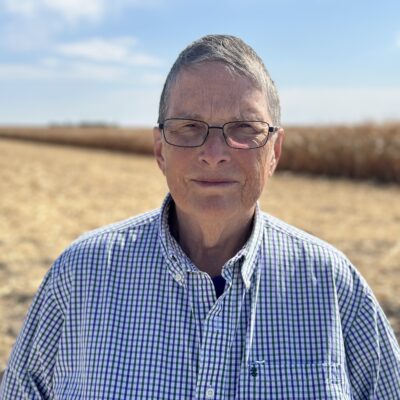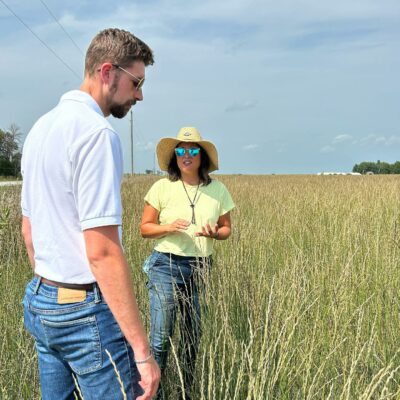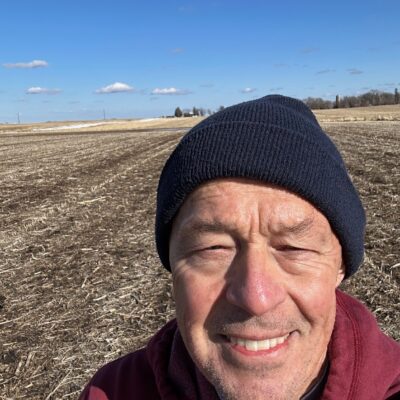Throughout 2023 and as Farm Bill drafting and negotiations continue in 2024, Climate Land Leaders have been voicing their support for a Farm Bill that prioritizes climate, meets farmer demand for conservation, and grows resilient farms and rural economies. As one said, federal conservation programs are “for right now and for future generations.” Climate Land Leaders’ on-the-ground experiences illustrate the many benefits of conservation, from ecological to economic, from farm to local community. Their stories and calls to action are inspiring, and we’ve compiled some of them here.
“For right now and for future generations”

“It’s been 25 years since my first Conservation Reserve Program (CRP) project – 20 acres of lowland that often got flooded along Beaver Creek. As I realized that it probably shouldn’t be in cropland, I learned about CRP and made arrangements to put that land in the program. Next I put in CRP as a buffer strip on another farm. I started with the most obvious things, things that could be done and didn’t seem like that much of a financial risk. Then as I started learning about regenerative agriculture, I realized I was just scratching the surface. I became intrigued — what more could I put into permanent plantings? That led me to put the 77-acre border around the organic crop field.
“The U.S. agricultural system has an entrenched history of making production agriculture its top priority at great risk to the environment and rural communities. It is urgent that there be a quantum shift with much more USDA funding for federal conservation programs. They are key avenues for promoting soil, water, and air quality as well as biodiversity in pursuit of counterbalancing and correcting the trajectory of the prevailing system.”

Tim Welsh wanted to increase productivity on his pastures and improve water and biodiversity on his farm. He used the Environmental Quality Incentives Program (EQIP) funding to fence off ponds and install water lines for better water quality and supply for the cattle. The project also included interseeding legumes into the pasture to improve the forage quality and carrying capacity. Tim reports that the farmer who grazes the pastures has been able to increase the stocking rate between 30-50%, and Tim has observed more wildlife and birds on the land. EQIP is one of the flagship working lands conservation programs funded in the Farm Bill, and it continues to be oversubscribed: less than one third of farmers who apply receive contracts.
Says Tim: “Federal funding for EQIP and other working lands conservation programs is a sensible investment for farmers, American society, and the planet. EQIP and other USDA programs targeted at well-managed grazing of perennial pastures improves vegetation cover, soil retention and health, and farm income. Communities benefit from cleaner water, reduced flooding, more biodiversity, soil carbon storage, and a more sustainable food supply. We’ve seen this first hand on our farm in northeast Iowa.”
“Ironically, the increase in extreme weather swings is making it even riskier for farmers to make the conversion to climate-smart conservation practices. We have found that one reason our renters are reluctant to make any changes in their current corn-soybean rotation is that the crop insurance program on which they depend actually makes it economically unwise for them to make changes.
“We need a farm bill that makes it more economically attractive to diversify and improve soil quality, as well as protect water quality and biodiversity. A climate-resilient system is necessary for the long-term social and economic well-being of the rural Midwest.” -Deb Paulson, Todd County, MN

“I took Senator Grassley’s staff person on a tour of the farm, showing him how important conservation dollars are for farmers like me and how they have helped protect our valuable soil and water amidst extreme weather events that are becoming more common, all while providing a beginning farmer an opportunity to add value to an existing conventional farm when buying farmland is too out of reach.
“I’m really proud of what I’ve built, where I’m at and of where I’m going, and I want to protect those valuable conservation dollars within the Inflation Reduction Act. I also promoted the Agriculture Resilience Act stressing the importance of agricultural research for crops and systems outside of corn and beans. I want a strong Farm Bill that protects conservation, helps grow more farmers and helps build resilient rural communities.”
Wendy has written two op-ed pieces for Civil Eats: Farmers Want Climate Resilience (October 2023) and We Need a New Farm Bill – for My Iowa Farm and Beyond (April 2023)

Jim Sayers’ cropland is on the lower end of a drainage district, which means that neighboring fields drain before Jim’s do – and a portion of Jim’s fields frequently flooded. He was replanting every 3 years, some years not replanting at all, and that history was adding up. Jim began serving as a commissioner with his county Soil and Water Conservation District where he learned more about the tools and resources available for conservation. Jim decided to establish a 27 acre wetland using CRP funding.
Jim also shares that the conservation projects serve his aim to make the farm more sustainable long-term: “There are more birds and wildlife. My neighbor who combines wants to come hunt pheasants. And because the wetland is lower in the tile line it can be a buffer for nutrient management – not just my soil but the neighbors’, which is a benefit for everyone.
“Federal funding for conservation, including the Conservation Reserve Program, is important because it encourages implementation of conservation efforts by individual producers and recognizes the social good these efforts provide for the public at large.”
“EQIP is for right now and it’s for future generations. The program is an excellent use of taxpayer dollars, and it benefits everyone.” -Ruth Rabinowitz, Madison County, IA

Naima Dhore grows food for communities in her region and has firsthand experience with extreme heat, increases in pest pressure and shifting weather patterns. As she expands her production on land that came without infrastructure, Naima is using funds from the EQIP program to add a high tunnel for season extension and a well and fencing, as well as plant trees, shrubs and pollinator habitat.
Says Naima: “EQIP funding availability and accessibility to a small farm like ours is crucial for multiple reasons. Firstly, it has a significant financial impact, enabling us to enhance our environmental conditions especially working with a new land. This funding will support improvement in soil health, pest management, and operational costs reduction. In addition, it will empower us to reinvest cost-share funds into other critical areas of the farm. EQIP funding provides smaller farms with a valuable advantage and encourages ongoing growth and development.”

Ruth Rabinowitz manages farms in Iowa and South Dakota and has implemented multi-species cover crops on all of the farms and installed a solar watering station for cattle grazing on her South Dakota cropland. Ruth is using funding and technical assistance from EQIP for these projects.
Says Ruth: “We want to be proactive. Whatever ball we can get ahead of and start making changes on the land now with landowners and farmers who are ready to go and excited – that’s an excellent use of taxpayer dollars. You have a group of landowners and farmers who want to do the right thing on their farms; by helping them do the right thing you’re going to get there faster.”
“We would not have been able to make these changes, all of which improve water quality and soil health, without utilizing government programs. We consider ourselves fortunate, as EQIP is always oversubscribed … that’s why the conservation funding in the Inflation Reduction Act, which will boost EQIP and other conservation programs, is so important to farmers, to the health of farm families and to our changing climate.” -Meg Nielsen, Freeborn County, MN, writing to the Austin Daily Herald

Dick Sloan was an early adopter of soil and water conservation practices on his cropland, including no tillage, multi-species cover crops, nutrient management, Integrated Pest Management, grassed waterways and field borders, and reintroduction of a small grain rotation.
Through two Conservation Stewardship Program (CSP) contracts over 10 years, Dick received payments and access to technical assistance that supported his ongoing investment in these practices. The results? Soil that stays in place, retains water and is rich in biology; healthy plants that take up nutrients; reduced nitrates in drainage water; reduced input costs; and increased biodiversity on the farm.
Says Dick: “Working lands conservation programs such as CSP empower farmers to choose the water quality and soil health practices that address resource concerns on individual farms across the country. Having a 5-year contract helped me keep my commitment to change the way I farmed to a more sustainable and resilient system. I see the difference 10 years has made in my soils, and I want the programs that helped me to be available to more farmers.”

Continuing their parents’ legacy of conservation on family farmland, the Bouska sisters are steadily working toward their vision of becoming a regenerative farm. They are implementing cover crops with their farming tenant and have planted pollinator habitat, windbreaks and 4,500 trees and shrubs. They have also restored a wetland on the farm.
Says Carol Bouska: “EQIP and CRP have enabled us to improve our soil and water quality health and increase biological diversity for habitat. We may implement some of these efforts without the payments, but not to this extent. These programs ultimately help us as a small farm to protect soil and water on our own land and also for the local community. We have been using these programs for 40 years, since our parents were farming, but we are expanding our conservation because of the support of these programs.”